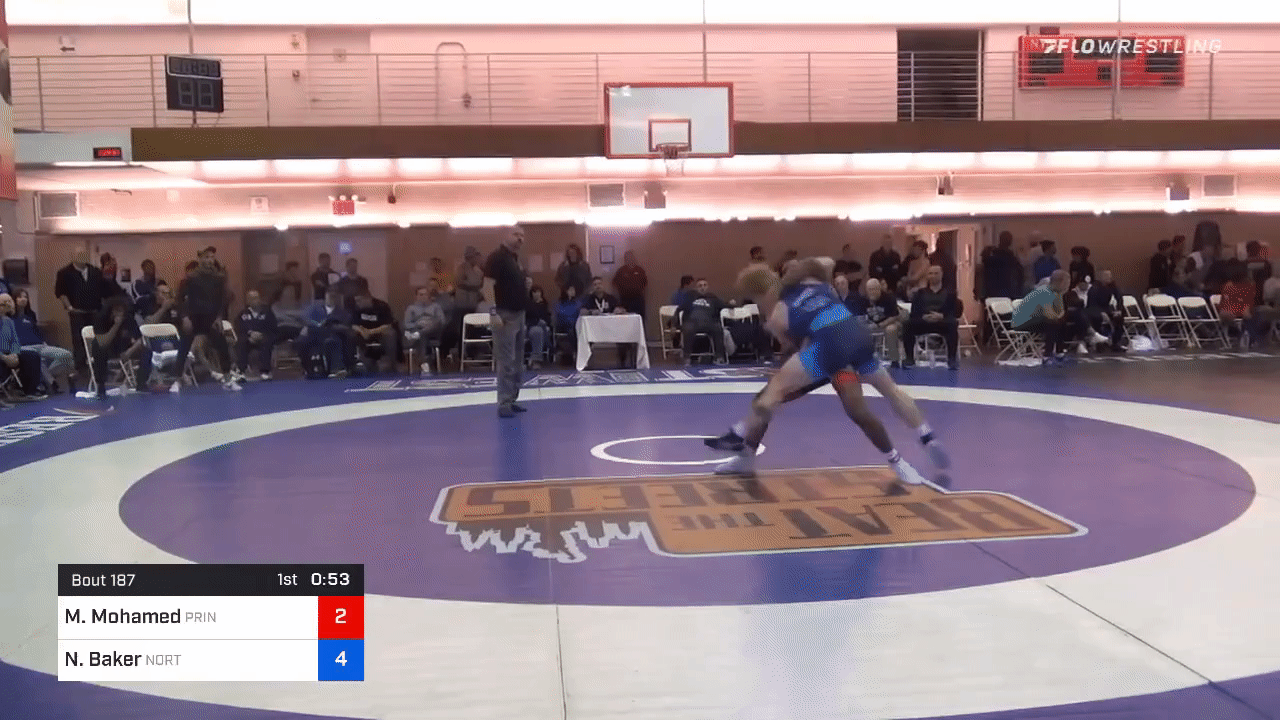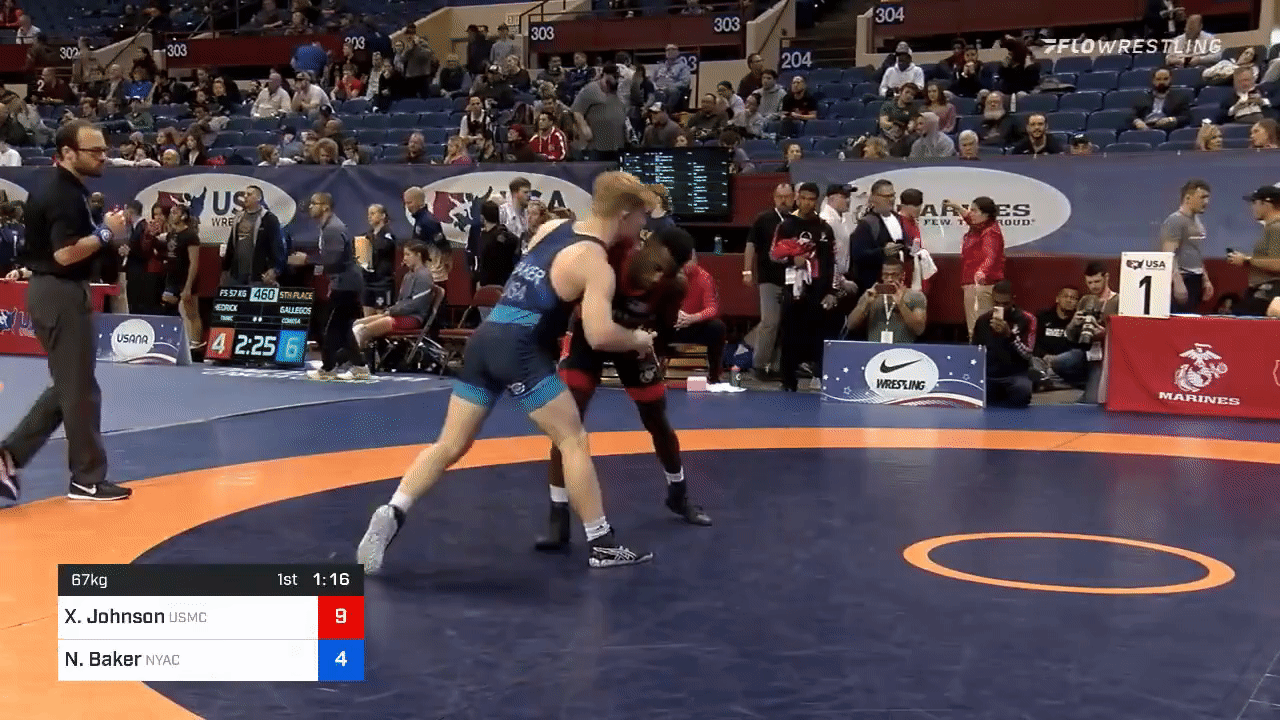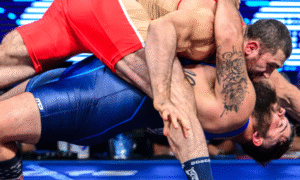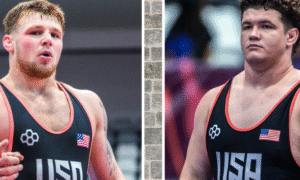Each of the first three articles on Greco-Roman statistical categories focused only on one competitor. In the opening piece, it was Joe Rau (87 kg, TMWC/IRTC, world #7), the second saw Kamal Bey (77 kg, Sunkist) highlighted, and the recent deep dive revolving around par terre stats put Max Nowry (55 kg, Army/WCAP, world #3) front and center.
There are several well-known US Seniors still remaining who are certainly worthy of closer inspection. Just one glance at G’Angelo Hancock‘s (97 kg, Sunkist, world #8) ledger the past two seasons tells you that if his numbers were broken down accordingly, they would knock your eyeballs out. And, to be sure, there will come a time for that. Ryan Mango (60 kg, Army/WCAP), too (he’s actually up next). Alex Sancho (67 kg, Army/WCAP), and Xavier Johnson (67 kg, Marines) are two other superb examples. We already know going in that these are athletes who pile up points. We’ve seen it up close and often. As such, they are more than deserving of the leg work involved.

But the reason why Nolan Baker (67 kg, NYAC) is being isolated over the above quartet, for now, is very simple: efficiency against high-level domestic opposition despite his status as a Senior neophyte.
The majority of Baker’s Senior victories have been pins. Not tech falls, and not grind-’em-out decisions. And that is a little out of the ordinary. Pins are not exactly uncommon in Greco, but they are witnessed most often in the upper-weights, or when there is a clear disparity in skill and experience between two wrestlers. Neither case applies to Baker. The lion’s share of his opponents have been top-quality in a weight class that, heading into the 2021 Olympic Trials, might be the best the US has to offer in terms of overall talent.
For the purpose of this exploration we are only looking at Baker’s three Senior tournaments contested this past year on US soil. He actually competed in five events last season, counting the U23 Trials and the Haparanda Cup in Sweden. Because Senior domestic competition is really how Baker should be measured, specifically in an Olympic Year, that is where the focus will reside, which is why U23 is being x’ed out of the discussion. Plus, neither the U23 Trials or Haparanda offered much in the way of deviation from his typical offensive markers. There were no outliers with which to be concerned about excluding.
For full explanations regarding our statistics, these three articles may be helpful:
- Introduction to Greco-Roman statistical categories (Rau).
- Counter Scores (Bey).
- Par Terre (Nowry).
’19 World Team Trials Challenge Tournament
The tournament in Raleigh last May represented Baker’s arrival on the Senior circuit. He had won the U23 Trials in ’18, which to some counts as a Senior event. But it isn’t one.
The ’18 U23 Trials are not even necessary if the objective is showcasing Baker’s efficiency. At the Trials Challenge Tournament, Baker went 5-1, placed third, and of his five wins only one match went the distance. Numbers highlighted in blue are discussed after the jump.
OPA: 7.1
OPP: 4.7
PPM: 6.1
PPP: 4.1
VFR: 80%
CSPM: 11.5
AMV: 4.6
APM: 3.3
APP: 2.2
ACR: 2.2
MPSM: 1.8
TCSP: 14
CSA: 2.3
PTSM: N/A
PTEP: N/A
PTDR: 100%
PTPS: 0.0
Baker’s VFR (Victory Finish Rate) is notable because it was his first Senior event, which also happened to be the World Team Trials. Although he had won the ’18 U23 tournament impressively — and although most understood that his methodology was based largely around headlocks — the book was not completely out on him just yet. They knew enough to take Baker seriously, while at the same time figured that things would look a lot rougher for him once he hopped onto the Senior level. Obviously, that was wishful thinking on their part.
An ACR (Attempt Conversion Rate) below 3.0 is excellent. Baker converted at a rate of 2.2, which if you read the Bey piece, is tantamount to saying that he scored on nearly every other attempt — just like Bey did at the ’17 Junior Worlds. His MPSM (Multi-Point Scores Per Match) comes in very low at 1.8 but there is a very good reason for that. In two of his bouts, Baker achieved pins following just one technique. He pinned both Aaron Reynolds (Marines) and Benji Peak (Sunkist/NTS) with headlocks early in the first period.
Baker’s PTDR (Par Terre Defense Rate) of 100% is as good as it can possibly get but he was only on bottom par terre a total of five times. He had defended well against Hayden Tuma (Army/WCAP) in the quarters, his lone defeat of the tournament; and was just as effective opposite Morgan Flaharty (NYAC) in the second consolation round.
Baker wound up placing third. He did not qualify for a National Team spot due to having lost to Tuma, who had fallen to Jamel Johnson (Marines) in the best-of-three final. (Both of Baker’s pins from the tournament can be viewed in the clip below.)
’19 Bill Farrell Memorial
The Bill Farrell Memorial/NYAC International Open last November presented Seniors with their first shot at securing berths for the Olympic Trials, provided they had not done so previously. The result was the most packed version of the tournament in more than a few years with 67 itself overrun with talented individuals.
In order on the front side of the bracket, Baker faced Peak, ’19 Trials runner-up Michael Hooker (Army/WCAP), and reigning National champ Alex Sancho (Army/WCAP). He would lose to Sancho by a wide margin. An educational moment. But he got back on track in the consolation bracket with a pair of pins over two excellent competitors, Mostafa Mohamed (Princeton WC/EGY) and National runner-up Calvin Germinaro (Minnesota Storm).
OPA: 4.2
OPP: 4.2
PPM: 2.6
PPP: 2.6
VFR: 100%
CSPM: 8.2
AMV: 2.0
APM: 1.6
APP: 1.6
ACR: 2.6
MPSM: 1.2
TCSP: 8.0
CSA: 1.6
PTSM: N/A
PTEP: 0%
PTDR: 0.33
PTPS: 4.0
Right away, there are four potentially misleading numbers at the top, especially if you bypass the VFR. All of Baker’s matches in New York ended in the first period. This is, presumably, responsible for the somewhat-low “points per” categories (and the same goes for the “attempts” stats and Average Margin of Victory). But once you catch that his VFR was 100%, which means he either tech’ed or pinned in each match he won (pinned), then it starts making some sense.
Counter attacks were also helpful to Baker in this tournament. They directly led to his pin over Hooker and kept him in the game against Mohamed until the headlock that ended the match. All in all, this was a very Baker-esque performance offensively, though his par terre defense numbers were not fantastic. He was on par terre bottom a total of three times, and got turned twice: first by Hooker, though he stepped over and fought for a pin; and then by Sancho, who eventually won the tournament and qualified for the Trials by doing so. Baker earned bronze and was the second-highest-placing US competitor.

Baker (blue) and Mohamed were in the mist of putting together a highly-competitive match at the ’19 Bill Farrell Memorial until Baker was able to isolate head-and-arm in the last minute of the first period. (Image: FLOWrestling)
’19 US Nationals/Olympic Trials Qualifier
A strange feeling may wash over some when recalling December’s Nationals. For most US athletes, the tournament in Texas was the last of the season, as only a fraction of the Senior base went on to compete elsewhere following the New Year. And, of course, the Nationals were a big deal because the top-5 wrestlers in each weight not yet qualified sealed up their bids for the Trials.
Baker received the #5 seed and began in the round-of-32 and emerged victorious in his first three bouts (all first-period finishes) to reach the semifinal where he once again lost to Sancho, but this time he hung around till the end. Prior to that match, he had caught and decked Xavier Johnson (Marines) after landing on top of a throw attempt. The two would battle it out again for third place the next day in what quickly became one of the Top 10 Matches of the Year. Baker fell to Johnson in a wild, points-happy slugfest but qualified for the Trials by virtue of finishing 4th.
OPA: 6.5
OPP: 4.3
PPM: 5.8
PPP: 3.8
VFR: 75%
CSPM: 13.0
AMV: 5.25
APM: 2.5
APP: 1.6
ACR: 1.87
MPSM: 2.3
TCSP: 12.0
CSA: 2.0
PTSM: 1.3
PTEP: 100%
PTDR: 0.0
PTPS: 0.66
Three of Baker’s four victories were stoppages, and two of those three were recorded quite early in the first period. As mentioned, when a wrestler is ending matches in short order it means they are not spending enough time on the mat to accumulate points. That, plus Sancho grabbing a 5-0 shutout, are largely responsible for Baker’s OPA (6.5) and PPM (5.8) in Texas. However, both stats are actually higher than they were at the Farrell. Baker’s matches against the two Johnsons — his win over Jamel and his bronze match against Xavier — delivered his biggest points yields by far. Those two bouts alone rendered an MPSM of 3.5. When you consider that his first two matches of the tournament barely lasted over a minute, along with the fact that he scored zero points against Sancho, that he came away with an overall 2.3 MPSM is almost astonishing. So too is an AMV of 5.25 when minding the same circumstances.
While getting guys out of there in the first period does not lend itself well to piling up points, it can shine a light how devastatingly efficient a wrestler is performing. Baker’s ACR at the Nationals was 1.87. That suggests he converted scores less than every other attempt. Reminder: Baker’s main go-to is head-and-arm (headlock). Even though he did not score on every headlock attempt, his willingness (and confidence) from the position clearly translates to actionable opportunities. Use this example to laugh at anyone who tells you it is a low-percentage technique. It is not the craftsman’s tool that matters, it is the expertise.
12 counter score points acquired during a Senior event is a high number. For Baker, these points were earned in three matches. Again, you can thank the Johnson duo. Both athletes are sharp and aggressive, and both know how to work themselves into favorable positions. Favorable positions, standing or on the feet, lead to attacks. Baker likes attacks whether he’s the one doing the attacking or someone else. This is probably why he has garnered so much attention despite having just begun his Senior career.
Keeping in pattern, par terre did not factor mightily into Baker’s results. He was only in a static par terre offense position three times and scored on all three (gutwrenches). Similarly, there were not an abundance of defensive opportunities. Baker found himself in static PT defense once, and X. Johnson executed a four-point lift — and Baker immediately reversed for a pair of points.
Combining the Numbers
Below are Baker’s combined stats from his first three US Senior domestic tournaments.
Matches: 17
W/L: 13-4
OPA: 6.1
OPP: 4.5
PPM: 5.0
PPP: 3.6
VFR: 84.6%
CSPM: 10.7
AMV: 5.3
APM: 2.5
APP: 1.8
ACR: 2.15
MPSM: 1.82
TCSP: 34.0
CSA: 2.0
PTSM: 0.47
PTEP: 60%
PTB: 9
PTDR: 66%
PTPS: 0.47
In 17 Senior domestic bouts, only three athletes have defeated Baker. All three are or have been recent US National Team members (Tuma, Sancho twice, and X. Johnson).
Two stats above are underlined — VFR and ACR. That is because it is within these two categories where Baker can be understood the best. He is remarkably efficient at converting attempts and is ending matches at an extremely high percentile. These numbers suggest that a correlation exists between what happens when he attacks (or counters) and the rate in which he is finishing off opponents. When Baker puts people to their backs, they tend not to get up.
The “points per” categories at the top would mean more if Baker were mostly tech’ing guys out or lasting the full six minutes consistently. But he isn’t. Eight of Baker’s victories were pins. All eight occurred in the opening period. In total, he has only walked out for the second period during a domestic Senior match a paltry six times.

In their raucous second match at the ’19 US Nationals, this one for bronze, Baker was forced to double clutch on a first-period headlock attempt against Xavier Johnson. He executed the technique for two, and followed with a gutwrench — but Johnson never relented and wound up the victor via criteria 13-13. Johnson is one of three current US National Team members to have beaten Baker. He is also one of three to have lost to Baker, with his teammate Jamel Johnson and Michael Hooker being the others. (Image: FLOWrestling)
There has not yet been enough par terre action from which to draw any reasonable conclusions. You will notice that both Baker’s PTSM (Par Terre Scores Per Match) and PTPS (Average Par Terre Points Surrendered) are the exact same. In the three tournaments discussed here, he had a total of five offensive par terre chances and was successful three times (PTEP = 60%), scoring eight points (averaged across 17 matches = PTSM of 0.47). Baker was on par terre bottom a combined nine times in 17 matches and defended six times, giving up eight points (PTPS = 0.47).
Negligibility from par terre is not a bad thing. Or, it is not a bad thing if the athlete in question is competent in other important areas, which very much describes Baker on the feet. But — at the Olympic Trials the intensity will be raised, the level of opposition just as high, if not higher, and par terre defense could loom large against hardened competitors. For example, reigning three-time World Team member Ellis Coleman (Army/WCAP) snared his fifth US Open title last year with an 80% PTEP, a 4.0 PTSM, a VFR of 100%, and was turned precisely once — by Tuma in the first period of the 67 final.
If Baker is able to demonstrate improved, dependable par terre defense entering that tournament, it is not a stretch to forecast how much more difficult of a proposition he would present to some of the more decorated and experienced athletes with whom he might come across.
Summary
You refer to three tournaments as a sample size, not a “body of work”, since the latter connotates performance over a lengthier time interval. But resist the slight potential quibble over wordplay. Whatever you want to call Baker’s first three Senior tournaments, there is no dismissing what the numbers have to say. He is consistently making attempts, converting at a ridiculous rate, and is, or at least has been, pinning opponents 61% of the time.
Baker was just starting to grow accustomed to Senior competition when December arrived on the calendar. Word from the US Olympic & Paralympic Training Center prior to the season’s shutdown was that he had begun improving rapidly thanks to functioning in a full-time environment.
Just like X. Johnson, Germinaro, and the Junior bronze winning pair of Peyton Omania (CYC/MSU) and Alston Nutter (Sunkist/NTS) — and other athletes on the younger side — Baker is the recipient of a year’s worth of extra time to prepare for the Trials at an extraordinarily opportune time in his career.
We know enough about him now. Imagine how much more we’ll know then?
Listen to “5PM37: The wildman Sammy Jones” on Spreaker.
SUBSCRIBE TO THE FIVE POINT MOVE PODCAST
iTunes | Stitcher | Spreaker | Google Play Music


















